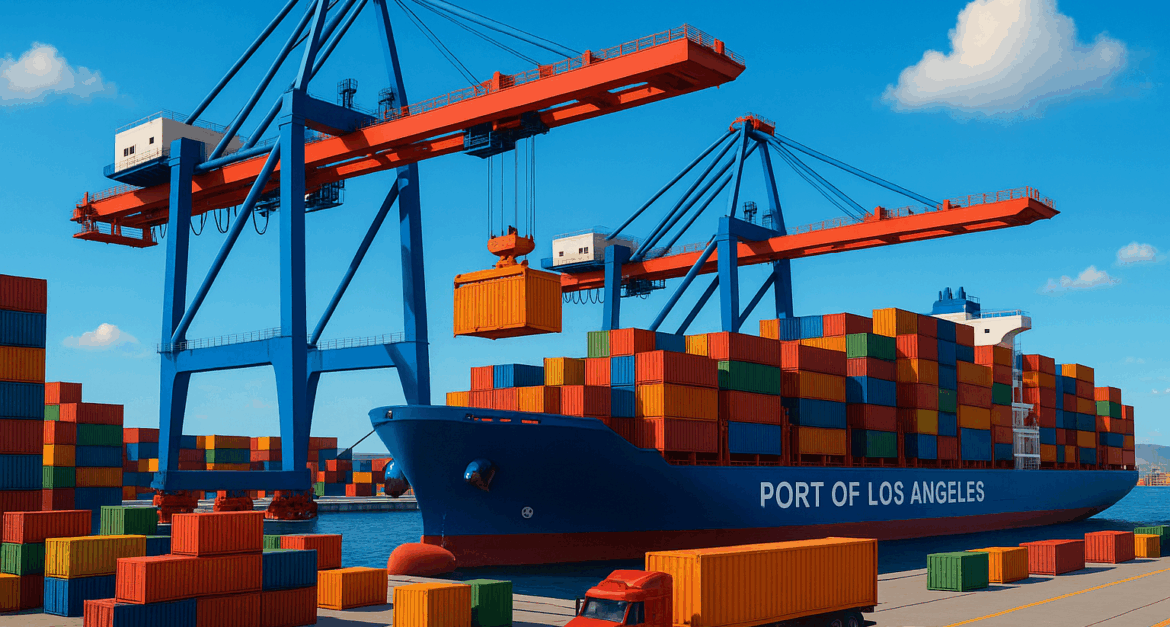
Introduction: A Surge with Strategy Behind It
In a dramatic move that’s catching the entire logistics world’s attention, the Port of Los Angeles reported its highest-ever June container volume—a staggering 892,340 TEUs processed in a single month. That’s an 8% jump year-over-year and a clear signal: importers are accelerating freight flow to get ahead of tariff hikes expected later this summer.
At AMB Logistic, we’ve seen the ripple effects firsthand—volume imbalances, tighter chassis availability, and urgent West-to-East reallocations. While the surge may be short-lived, its impact is immediate—and strategic.
Let’s unpack what drove this spike, what it means for U.S. logistics in Q3 and Q4, and how shippers should recalibrate their freight plans now.
Why the Sudden Volume Boom? It’s All About Timing—and Tariffs
With former President Trump’s pending tariff enforcement policies expected to return in mid-August, U.S. importers are executing a classic move: pulling forward inventory.
Key Drivers:
- Tariff Acceleration: Businesses want to avoid new duties on consumer goods, electronics, and industrial parts.
- Retail Forecasting: With Q4 peak season still in view, many retailers are hedging against geopolitical risk.
- Cost-Saving Calculations: The current ocean rate environment favors early arrivals over potentially tariff-laden loads later in Q3.
According to Port of LA Executive Director Gene Seroka, this June spike “represents one of the fastest front-load responses we’ve seen since 2019.”
Port Infrastructure: Holding Steady Under Pressure
Despite the dramatic increase in throughput, the Port of Los Angeles handled the surge with impressive resilience.
Terminal Performance Highlights:
- Average Dwell Time: Held steady at 3.9 days
- Truck Turn Times: Down to 83 minutes at peak
- On-Dock Rail Moves: Up 5% month-over-month
While chassis shortages and weekend gate congestion presented operational challenges, there were no major vessel backlogs, thanks in part to improved yard management tech and carrier coordination.
For AMB Logistic and our carrier partners, it meant fewer demurrage events—but significantly more pressure on drayage capacity.
Ripple Effects: What It Means for the Broader Freight Market
This June surge isn’t just a West Coast phenomenon. It’s now reshaping logistics patterns across the U.S.
1. Intermodal Rebalancing
Eastbound rail lanes (LA → Dallas, LA → Chicago, LA → Atlanta) saw surging volume. Intermodal transit times remained stable, but spot capacity tightened rapidly.
2. Regional Warehousing Pressures
Southern California DCs—already operating near capacity—reported 35–60% increases in inbound pallets, straining short-term labor and inventory control systems.
3. Trucking Rate Shifts
Freight brokers saw rate jumps of 6–9% on dry van loads originating near LA/Long Beach due to urgent repositioning demands.
What Comes Next: Surge Today, Slowdown Tomorrow?
Industry analysts caution this spike may not last. With many importers pulling orders ahead of schedule, Q3 volumes could dip sharply, creating a “freight whiplash” effect.
Watch for:
- Q3 Volume Decline (esp. August–September)
- Inland Congestion in Dallas, Kansas City, and Chicago
- Shipper Hesitation on new orders due to tariff and election uncertainty
At AMB Logistic, we’re preparing both surge-response protocols and post-surge balancing strategies to support clients across scenarios.
AMB Recommendations: How Shippers Should Respond
1. Re-Evaluate Inventory Timing
If you’ve front-loaded inventory already, review your warehousing efficiency and fulfillment plans for August–October.
2. Monitor Tariff Announcements Closely
Any new policy could impact cost structures and transit planning for Q4. Stay flexible and update landed cost projections weekly.
3. Use Tier-2 Ports Where Possible
Expect Savannah, Houston, and Norfolk to absorb spillover if LA slows. Diversification reduces chokepoint exposure.
4. Partner With Agile Freight Providers
Whether it’s rerouting loads, shifting from ocean to intermodal, or managing short-term overflow—speed and visibility will win the quarter.
AMB Logistic: Supporting Your Freight Strategy in Any Cycle
We’re not just watching the surge—we’re navigating it.
At AMB Logistic, we’ve already deployed:
- Surge routing logic in our TMS
- Drayage partnerships to absorb overflow
- Live ETA dashboards for high-volume customers
- Q3/Q4 freight modeling tools for strategic forecasting
Whether volume spikes or slows, we’re here to deliver clarity, control, and consistency.
Closing Thought: Don’t Just React—Reposition
The June surge isn’t just a headline—it’s a reminder that timing is strategy in modern logistics. The best-positioned supply chains are already thinking three months ahead.
Because in freight, as in markets, the winners don’t just adapt to pressure—they plan for it.
Contact AMB Logistic
📧 info@amblogistic.us
🌐 www.amblogistic.us
📞 +1 (888) 538-6433
Tags: Port of Los Angeles, June Volume Record, Tariff Acceleration, Freight Planning, Ocean to Rail, Intermodal Strategy, AMB Surge Management, West Coast Logistics, Retail Import Timing, U.S. Supply Chain Outlook




